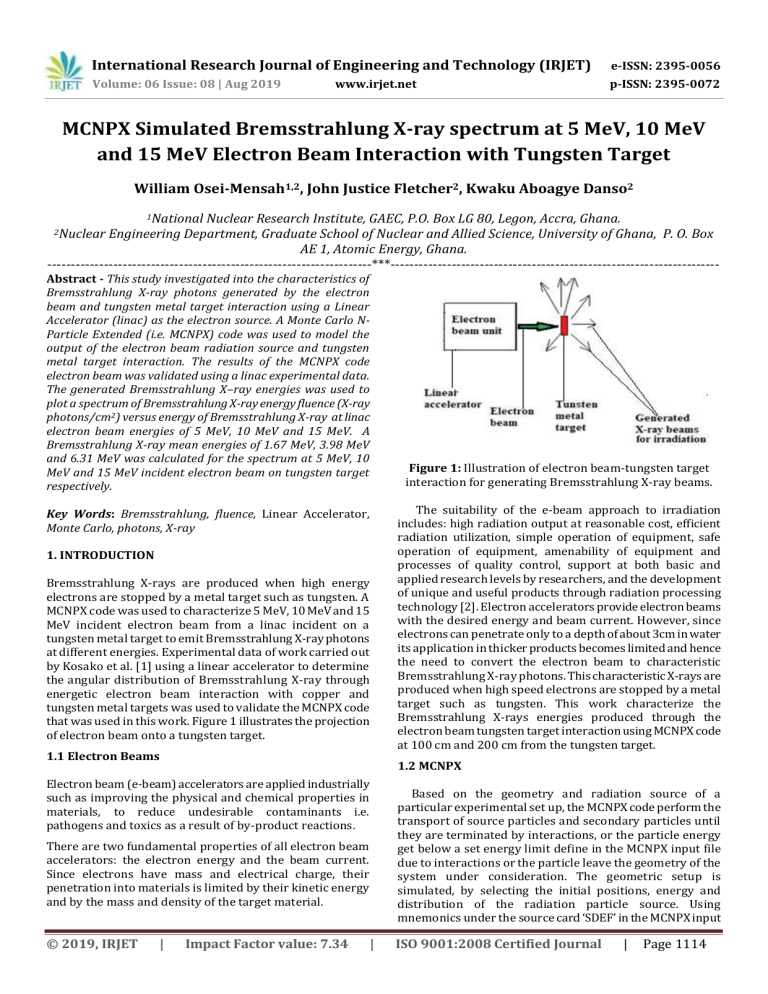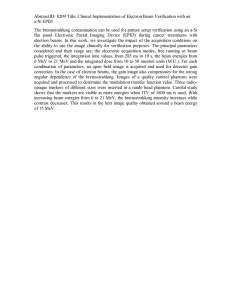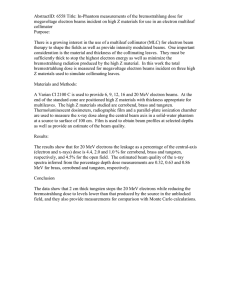IRJET-MCNPX Simulated Bremsstrahlung X-Ray Spectrum at 5 MeV, 10 MeV and 15 MeV Electron Beam Interaction with Tungsten Target
advertisement

International Research Journal of Engineering and Technology (IRJET) e-ISSN: 2395-0056 Volume: 06 Issue: 08 | Aug 2019 p-ISSN: 2395-0072 www.irjet.net MCNPX Simulated Bremsstrahlung X-ray spectrum at 5 MeV, 10 MeV and 15 MeV Electron Beam Interaction with Tungsten Target William Osei-Mensah1,2, John Justice Fletcher2, Kwaku Aboagye Danso2 1National Nuclear Research Institute, GAEC, P.O. Box LG 80, Legon, Accra, Ghana. Engineering Department, Graduate School of Nuclear and Allied Science, University of Ghana, P. O. Box AE 1, Atomic Energy, Ghana. ---------------------------------------------------------------------***---------------------------------------------------------------------2Nuclear Abstract - This study investigated into the characteristics of Bremsstrahlung X-ray photons generated by the electron beam and tungsten metal target interaction using a Linear Accelerator (linac) as the electron source. A Monte Carlo NParticle Extended (i.e. MCNPX) code was used to model the output of the electron beam radiation source and tungsten metal target interaction. The results of the MCNPX code electron beam was validated using a linac experimental data. The generated Bremsstrahlung X–ray energies was used to plot a spectrum of Bremsstrahlung X-ray energy fluence (X-ray photons/cm2) versus energy of Bremsstrahlung X-ray at linac electron beam energies of 5 MeV, 10 MeV and 15 MeV. A Bremsstrahlung X-ray mean energies of 1.67 MeV, 3.98 MeV and 6.31 MeV was calculated for the spectrum at 5 MeV, 10 MeV and 15 MeV incident electron beam on tungsten target respectively. Key Words: Bremsstrahlung, fluence, Linear Accelerator, Monte Carlo, photons, X-ray 1. INTRODUCTION Bremsstrahlung X-rays are produced when high energy electrons are stopped by a metal target such as tungsten. A MCNPX code was used to characterize 5 MeV, 10 MeV and 15 MeV incident electron beam from a linac incident on a tungsten metal target to emit Bremsstrahlung X-ray photons at different energies. Experimental data of work carried out by Kosako et al. [1] using a linear accelerator to determine the angular distribution of Bremsstrahlung X-ray through energetic electron beam interaction with copper and tungsten metal targets was used to validate the MCNPX code that was used in this work. Figure 1 illustrates the projection of electron beam onto a tungsten target. 1.1 Electron Beams There are two fundamental properties of all electron beam accelerators: the electron energy and the beam current. Since electrons have mass and electrical charge, their penetration into materials is limited by their kinetic energy and by the mass and density of the target material. | The suitability of the e-beam approach to irradiation includes: high radiation output at reasonable cost, efficient radiation utilization, simple operation of equipment, safe operation of equipment, amenability of equipment and processes of quality control, support at both basic and applied research levels by researchers, and the development of unique and useful products through radiation processing technology [2]. Electron accelerators provide electron beams with the desired energy and beam current. However, since electrons can penetrate only to a depth of about 3cm in water its application in thicker products becomes limited and hence the need to convert the electron beam to characteristic Bremsstrahlung X-ray photons. This characteristic X-rays are produced when high speed electrons are stopped by a metal target such as tungsten. This work characterize the Bremsstrahlung X-rays energies produced through the electron beam tungsten target interaction using MCNPX code at 100 cm and 200 cm from the tungsten target. 1.2 MCNPX Electron beam (e-beam) accelerators are applied industrially such as improving the physical and chemical properties in materials, to reduce undesirable contaminants i.e. pathogens and toxics as a result of by-product reactions. © 2019, IRJET Figure 1: Illustration of electron beam-tungsten target interaction for generating Bremsstrahlung X-ray beams. Impact Factor value: 7.34 | Based on the geometry and radiation source of a particular experimental set up, the MCNPX code perform the transport of source particles and secondary particles until they are terminated by interactions, or the particle energy get below a set energy limit define in the MCNPX input file due to interactions or the particle leave the geometry of the system under consideration. The geometric setup is simulated, by selecting the initial positions, energy and distribution of the radiation particle source. Using mnemonics under the source card ‘SDEF’ in the MCNPX input ISO 9001:2008 Certified Journal | Page 1114 International Research Journal of Engineering and Technology (IRJET) e-ISSN: 2395-0056 Volume: 06 Issue: 08 | Aug 2019 p-ISSN: 2395-0072 www.irjet.net file, each particle from a specified source generated from a predefined initial position and the interaction of the particle in the geometry is tracked by the code until it is absorbed or leaked out of the experimental set-up. Secondary particles generated are also tracked until it is also finally absorbed or leaked. A new particle is again sampled from the specified radiation source and simulated in the same way. The process is repeated until a desired number of particle histories has been simulated or some other termination criterion is met. The number of particle histories (i.e. NPS) to be simulated are specified by the code user, the higher the NPS the more accurate the results however for complex geometries the simulation time and space required will need a faster computer and higher computer space for the simulation. electron beam energies. The Bremsstrahlung X-ray energy fluence spectrum from the tungsten metal were plotted. Energy bin tally ‘E0’ under the data cards of the MCNPX input file was used to group the Bremsstrahlung X-ray energies for the plotting against the X-ray fluence to yield the spectrum. The spectrum were plotted at 100 cm and 200 cm from the tungsten metal target. 2.3 Results and Discussion 2.3.1 Comparing results on the validation of MCNPX electron beam-tungsten X-ray output with work carried out by Kosako et al. 2010. 2. Method 2.1. Input file for the validation of the MCNPX code Experimental work by Kosako et al., 2010 [1] were used to validate MCNPX code, dimensions in Figure 2 was used to write the MCNPX input file for the experimental work carried out for the validation. Figure 2: Illustration of X-ray detector arrangement for determination of Bremsstrahlung due to electron beamtungsten metal target interaction (Kosako et al., 2010) for validation of MCNPX code used for this work. The angles at which the Bremsstrahlung X–ray photon flux, to be determined, are calculated in the x, y, z coordinate points. Six (x, y ,z ) locations, (-50, 0 ,0), (-43.3, 0 ,-25), (-35.4, 0, -35.4), (-25, 0, -43.3), (0, 0, -50) and (25, 0, -43.3) corresponding to angles 0°, 30°, 45°, 60°, 90° and 120° detector locations arranged around the tungsten target as illustrated in Figure 2 were used to acquire the Bremsstrahlung X-ray photon flux using ‘F5’ tally card specified under the data card in the MCNP input file. The simulation were carried out at the three electron beam energies (i.e. 18 MeV, 28 MeV and 38 MeV) at which the experimental work was performed by Kosako et al., 2010. 2.2. Input file for the determination of Bremsstrahlung Xray spectrum A MCNPX code input file was written for a linear accelerator head with tungsten metal as the target and simulated. The simulation was carried out at 5 MeV, 10 MeV and 15 MeV © 2019, IRJET | Impact Factor value: 7.34 | The calculated MCNPX angular Bremsstrahlung X-ray photon flux at 18 MeV, 28 MeV and 38 MeV electron beam interaction with the tungsten metal target were plotted and compared with the experimental plots. A MCNPX calculated relative dose rate versus detector locations at the six angles were plotted as shown in Figures 4, 6 and 8 respectively which gives similar values and trend as experimental data plot in Figures 3, 5, and 7. The similarity in value and trend validate the MCNPX code used in the Bremsstrahlung X-ray spectrum determined in this work. Figure 3: Angular distributions of dose rates by photons and electrons from tungsten (W) metal bombarded by 18 MeV electron beam. Kosako et al. 2010. Figure 4: MCNPX calculated angular distributions of dose rates by Bremsstrahlung X-ray from tungsten (W) metal bombarded by 18 MeV electron beam. ISO 9001:2008 Certified Journal | Page 1115 International Research Journal of Engineering and Technology (IRJET) e-ISSN: 2395-0056 Volume: 06 Issue: 08 | Aug 2019 p-ISSN: 2395-0072 www.irjet.net Figure 8: MCNPX calculated angular distributions of dose rates by Bremsstrahlung X-ray from tungsten (W) metal bombarded by 38 MeV electron beam. Figure 5: Angular distributions of dose rates by photons and electrons from tungsten (W) metal bombarded by 28 MeV electron beam. Kosako et al. 2010. Although the MCNPX results are for a particle of X-ray photons, it can be observed that calculated values are underestimated compared to the experimental data. This can be seen from the relative positions of the points on the plots. This must be due to the contribution from secondary radiations as a result of structures such as collimators and filters in the Linac used by Kosako et al., for the experimental data. Where as in this work the MCNPX input file did not include all the structures as a result of unavailability of the technical details of the experimental Linac used by Kosako et al. The good agreement of the MCNPX calculated values and the experimental data implies using the code to analyze Bremsstrahlung X-ray energies at 5 MeV, 10 MeV and 15 MeV electron beam energies produced reliable values. 2.4 Bremsstrahlung X-ray spectrum for the tungsten target Figure 6: MCNPX calculated angular distributions of dose rates by Bremsstrahlung X-ray from tungsten (W) metal bombarded by 28 MeV electron beam. The spectrum were determined at locations 100 cm and 200 cm from the tungsten metal target and the most probable uncollided X-ray energies of 2.51 x 10-1 MeV were observed at 5 MeV, 10 MeV and 15 MeV incident electron beam respectively. Figures 9 to 14 confirms the peak uncollided Bremsstrahlung X-ray spectrum corresponded to the most probable uncollided energy of 2.51 x 10-1 MeV. The mean Bremsstrahlung X-ray energies of 1.67 MeV, 3.98 MeV and 6.31 MeV was calculated for the spectrum at 5 MeV, 10 MeV and 15 MeV incident electron beam respectively. Figure 7: Angular distributions of dose rates by photons and electrons from tungsten (W) metal bombarded by 38 MeV electron beam. Kosako et al. 2010. © 2019, IRJET | Impact Factor value: 7.34 | ISO 9001:2008 Certified Journal | Page 1116 International Research Journal of Engineering and Technology (IRJET) e-ISSN: 2395-0056 Volume: 06 Issue: 08 | Aug 2019 p-ISSN: 2395-0072 www.irjet.net S Figure 11: Bremsstrahlung X-ray photon spectrum at 0° to the electron beam axis and 100 cm from tungsten metal target, at electron beam energy of 5 MeV. Figure 9: Bremsstrahlung X-ray photon spectrum at 0° to the electron beam axis and 100 cm from tungsten metal target, at electron beam energy of 15 MeV. Figure 12: Bremsstrahlung X-ray photon spectrum at 0° to the electron beam axis and 200 cm from tungsten metal target at electron beam energy of 15 MeV. Figure 10: Bremsstrahlung X-ray photon spectrum at 0° to the electron beam axis and 100 cm from tungsten metal target, at electron beam energy of 10 MeV. © 2019, IRJET | Impact Factor value: 7.34 | ISO 9001:2008 Certified Journal | Page 1117 International Research Journal of Engineering and Technology (IRJET) e-ISSN: 2395-0056 Volume: 06 Issue: 08 | Aug 2019 p-ISSN: 2395-0072 www.irjet.net locally design a shielding containment for industrial linear accelerator implies 32% to 23 % cost of acquiring a linear accelerator will be saved [4]. The 32% to 23 % reduction in acquiring the linear accelerator means more linear accelerators can be acquired at a lower cost to perform commercial irradiation. ACKNOWLEDGEMENT Financial support from the Government of Ghana through the Ghana Education Trust Fund (GETFund) and support from the Graduate School of Nuclear and Allied Sciences, University of Ghana is gratefully acknowledged. REFERENCES [1] Kosako, K., Oishi, K., Nakamura, T., Takada, M., Sato, K., Kamiyama, T., and Kiyanagi, Y. 2010. Angular Distribution of Bremsstrahlung from Copper and Tungsten Targets Bombarded by 18, 28, and 38 MeV Electrons. Journal of Nuclear Science and Technology, Vol. 47, No. 3, p. 286–294. [2] IAEA Radiation Technology Series No.1, 2010. Use of mathematical modelling in electron beam processing: A guide book. International Atomic Energy Agency, ViennaAustria. Figure 13: Bremsstrahlung X-ray photon spectrum at 0° to the electron beam axis and 200 cm from tungsten metal target at electron beam energy of 10 MeV. [3] IAEA- International Consultative Group on Food Irradiation: The development of X-Ray machines for food irradiation. Vienna Austria 1995. P. 2-3 [4] Mentzer, R., M., 1989. An economic analysis of electron accelerators and cobalt-60 for irradiating food. United States Department of Agriculture. Figure 14: Bremsstrahlung X-ray photon spectrum at 0° to the electron beam axis and 200 cm from tungsten metal target at electron beam energy of 5 MeV. These spectrums can be used to manually calculate the dosage at locations 100 cm and 200 cm from the tungsten target using photon flux to dose conversion factors such as, the American National Standard Institute/American Nuclear Society Flux-to-Dose Rate Conversion Factors i.e. ANSI/ANS–6.1.1–1977. 3. CONCLUSION The successful results of using MCNPX for the calculation of the X-ray energy spectrum at 5 MeV, 10 MeV and 15 MeV electron beam-tungsten metal target interaction implies future analysis for the dosage planning of industrial accelerators using Bremsstrahlung X-ray for irradiation can be done locally. Also the shielding effectiveness of local materials can be considered as an alternative radiation shielding materials in the shielding application of linear accelerators for industrial irradiation [3]. Being able to © 2019, IRJET | Impact Factor value: 7.34 | ISO 9001:2008 Certified Journal | Page 1118


